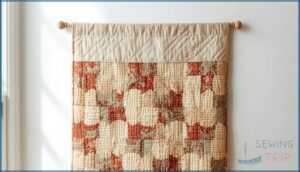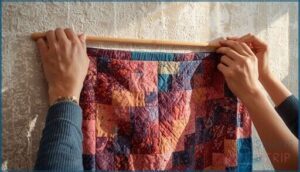This site is supported by our readers. We may earn a commission, at no cost to you, if you purchase through links.
That heirloom quilt your grandmother stitched by hand deserves better than living folded in a closet. Hanging a quilt transforms it from storage item to stunning focal point, but the wrong approach can damage delicate fibers or leave you with a crooked display.
The key lies in matching your hanging method to your quilt’s specific weight, fabric type, and the wall surface you’re working with. A lightweight cotton throw needs different support than a heavy wool quilt, and drywall mounting differs entirely from brick or plaster.
Getting it right means your quilt stays secure, looks professional, and lasts for years without sagging or sun damage.
Table Of Contents
- Key Takeaways
- Preparing Your Quilt for Wall Hanging
- Choosing The Best Hanging Method
- How to Hang a Quilt With Sleeves
- Alternative Quilt Hanging Techniques
- Step-by-Step Guide: Hanging With Rod Systems
- Creative Display Ideas for Quilts
- Top 5 Quilt Hanging Products for Walls
- Frequently Asked Questions (FAQs)
- Conclusion
Key Takeaways
- Matching your hanging method to your quilt’s weight, fabric type, and wall surface prevents damage and sagging—lightweight cotton throws need different support than heavy wool quilts, and drywall mounting differs from brick or plaster.
- Fabric sleeves sewn to the back of your quilt distribute weight evenly across the top edge and are the most trusted museum-quality method, preventing strain and sagging over time while keeping hardware hidden.
- Protecting quilts from UV damage and heat is critical since direct sunlight accelerates fiber degradation by up to 80%—use UV-filtering window film, keep displays at least three feet from vents, and rotate quilts every few months.
- Alternative hanging methods like command strips, clamps, or magnetic systems work well for temporary displays or renters, but you need to respect weight limits and use multiple attachment points spaced 12-18 inches apart for proper support.
Preparing Your Quilt for Wall Hanging
Before you put a single nail in the wall, you need to take a few minutes to prepare your quilt properly. Getting these basics right from the start protects your quilt and makes the hanging process much easier.
Let’s walk through the essential steps you should take before choosing your hanging method.
Measuring The Quilt Dimensions
Accuracy is everything when hanging a quilt—precision ensures your display looks balanced and secure. Measure your quilt after binding is complete to account for dimension variance from seams and quilting shrinkage.
Here’s what you need:
- Measure width and length at the top edge for hanging calculation
- Use a clear ruler after pressing for accuracy importance
- Check for size standardization against industry charts
- Account for 4-8 inch variations in finished dimensions
- Note measurement trends—sleeve width generally needs 4 inches
These steps make quilt hanging and quilt display simpler. It’s important to remember that you can use a quilt size chart as a general guide.
Assessing Quilt Weight and Fabric
Once you know your quilt’s dimensions, check its weight and fabric GSM—this determines support requirements and hanging safety. A lightweight throw around 2 lb. works with simple dowels, while queen-sized quilts at 5 lb. need metal rods for material durability. Cotton weaving resists gravity better than loose blends.
Heavier fabric demands stronger support when hanging a quilt to prevent sagging. Many quilters use a hanging sleeve method for secure display.
Selecting The Ideal Wall Location
After confirming weight and fabric, scan your home for the perfect spot. Living rooms and entryways work best for displaying quilts, accounting for 58% of placements.
Check wall material for secure mounting, and step back six feet to judge viewing distance. Avoid spots near windows with direct sunlight exposure or vents with fluctuating humidity levels—both threaten damage-free display.
Choose a location that enhances home decor while keeping your quilt safe.
Protecting Quilt From Sunlight and Heat
Once you’ve found the right wall, protecting quilts from UV damage becomes your next priority. Direct sunlight accelerates fiber degradation by up to 80%, while heat exposure from nearby vents weakens fabric structure.
Install UV-filtering window film to block 99% of harmful rays, and keep your display at least three feet from radiators.
Display rotation every few months gives fabric a rest, greatly extending its lifespan through these protective measures.
Choosing The Best Hanging Method
Not every quilt hangs the same way, and what works for a lightweight baby quilt won’t cut it for a heavy heirloom piece. Your wall surface matters too—drywall, plaster, and brick each need different approaches.
Let’s walk through how to match your quilt’s size and weight to the right method, so it stays secure and looks great on your wall.
Evaluating Quilt Size and Weight
Size impact and weight distribution determine which hanging methods you can safely use. Miniature quilts under 36 inches square weigh less than 2 pounds, while queen-size wall quilts reach 5 pounds or more. Fabric density and batting choices directly affect this weight.
For display safety, weigh your quilt before choosing hardware—quilts over 8 pounds need reinforced sleeves or multiple mounting points to prevent sagging.
Considering Wall Type and Surface
Drywall limitations matter here—standard hooks hold quilts up to 20 pounds, but heavier pieces need toggle anchors to avoid wall damage. For damage-free display, command hooks work best on smooth drywall, offering picture-hanging strength without the commitment.
Plaster concerns include cracking risk without proper bracing, plus adhesive strips fail 22% of the time on uneven surfaces.
Brick factors in mildew—17% higher behind quilts than other walls.
Pros and Cons of Popular Methods
Each quilt hanging technique brings trade-offs worth considering. Hanging sleeves offer sleeve longevity and even weight distribution, but they’re labor-intensive to install. Clip visibility can distract from your quilt display options, though they’re budget-friendly. Command strips provide damage-free strip reusability, while rod aesthetics improve your space but require drilling. Loop stability works for lightweight quilts under 5 pounds, making proper quilt care essential when choosing among these quilt hanging techniques.
How to Hang a Quilt With Sleeves
A fabric sleeve sewn to the back of your quilt is one of the most trusted methods museums and quilters use to hang textiles safely. It distributes weight evenly across the top edge, so your quilt won’t sag or strain over time.
Here’s how to create and attach a sleeve, then mount your quilt securely on the wall.
Cutting and Preparing The Sleeve
When you’re ready to create your hanging sleeve, start by cutting an 8.5-inch wide strip that matches your quilt’s full width. Use muslin or fabric matching your backing for sleeve fabric selection.
Fold both short ends twice, about 1/4 inch each time, then stitch close to the edges. This edge finishing technique prevents fraying and outfits your sleeve for the rod.
Hand-Stitching The Sleeve to The Quilt
Once your fabric preparation is complete, you’ll position the sleeve about 0.5 inches below the top binding, keeping it hidden when displayed. Pin it carefully along the backing, then use a whip stitch or blind stitch to sew sleeves in place.
For successful sleeve attachment, follow these steps:
- Choose 50wt cotton thread for thread selection that’s strong yet nearly invisible
- Stitch both top and bottom edges securely without piercing through to the quilt front
- Use stitch patterns like blind stitch to maintain a flat, professional appearance
- Keep the sleeve flat against the backing with no puckers or stretching
- Stop stitching 1 inch before each side binding to prevent corner stress
This hand stitching method creates a reliable hanging method that distributes your quilt’s weight evenly. Most quilters complete this hanging sleeve process in under two hours, making it a manageable afternoon project. The result? A sturdy quilt hanger system that’ll keep your work secure for years.
Inserting and Sizing The Dowel or Rod
Your choice of dowel rod directly affects how well your quilt hangs, so measure carefully.
For quilts up to 36 inches wide, use a 3/8 to 1/2 inch diameter wooden quilt rod. Cut it 1 to 2 inches shorter than your quilt’s width so it stays hidden inside the sleeve.
This dowel selection ensures proper weight distribution and prevents visible bulging at the top edge.
Mounting The Quilt Safely on The Wall
Now that your rod fits snugly inside the hanging sleeve, it’s time to secure everything to the wall. Use wall anchors rated for your quilt’s weight, paired with mounting hardware like brackets or sturdy picture hangers. This creates a damage-free display while providing proper fabric protection.
- Metal brackets positioned level with a carpenter’s tool
- The hanging rod sliding smoothly through the sleeve’s fabric tunnel
- Your quilt lifted gently, suspended an inch from the wall surface
- Command strips reinforcing lighter quilt slats for added security
Alternative Quilt Hanging Techniques
Not every quilt needs a sleeve sewn to its back. Sometimes you want a faster setup, a temporary display, or a method that keeps the fabric completely untouched.
Below are four practical alternatives that give you flexibility without sacrificing support or style.
Using Hanging Loops or Triangles
Hanging loops spaced about 10 inches apart give your quilt stability without the bulk of a full sleeve. These small fabric strips, usually 1.5 to 2 inches long, support quilts beautifully when hand-stitched along the top edge.
Triangle support in the corners works well for smaller quilts, holding up to 10 pounds while keeping hanging hardware nearly invisible and preserving fabric durability.
Hanging Quilts With Clamps or Clips
Clamps and clips offer quick, no-sew hanging for your smaller quilts. You’ll find they work best for pieces under 60 inches wide, with heavy-duty quilt clamps holding 5–6 pounds each. Space them every 12–18 inches along the top edge to prevent sagging.
- Choose felt-lined clamps to reduce fabric damage risk and compression marks
- Place clips evenly to maintain straight alignment and professional appearance
- Look for wood, metal, or padded clip material trends matching your décor
- Rotate hanging points periodically to preserve heirloom quilts and minimize strain
Damage-Free Hanging With Command Strips
Command Strips offer a damage-free alternative when clamps won’t work. Large strips hold up to 16 pounds total—plan on four or more for quilts over eight pounds.
Clean your wall and quilt backing first; adhesive strips need smooth, dry surfaces to grip properly. Space them every 5–6 inches along the top edge. Pull straight down during removal to avoid lifting paint.
Magnetic and Hook-and-Loop Solutions
For quick swaps or fragile textiles, magnetic hanging systems use rare-earth magnets that hold up to 15 pounds. Both methods protect your wall display without punctures, and their display versatility lets you rotate quilts in minutes for seasonal changes or special occasions.
Hook-and-loop fasteners—sewn onto twill tape along your quilt’s top edge—offer even weight distribution and fabric preservation across wide spans.
Step-by-Step Guide: Hanging With Rod Systems
Rod systems give your quilt sturdy, even support across the top edge, making them one of the most reliable hanging methods. The process involves measuring your space, securing the hardware to your wall, and sliding the rod through a sleeve or attaching the quilt directly.
Here’s how to set up a rod system step by step.
Measuring and Cutting The Rod
Rod length calculation starts with your quilt’s width, minus about 0.5 inches so the dowel rod stays hidden. You’ll want a diameter between 0.5 and 1 inch for most quilts—wood dowel or metal rod both work beautifully.
Measure twice, then cut with a hacksaw or pipe cutter. Smooth the ends with sandpaper and slide it through your sleeve for fit verification before mounting.
Installing Brackets or Picture Hangers
Before your quilt becomes a stunning piece of wall decor, solid bracket installation sets the stage for a damage-free display. Find your studs with a finder, mark level points with a pencil, then drill pilot holes for wall anchors.
Metal or hardwood brackets hold up to 80 lbs when secured properly—choose anchor types matched to your wall surface for best weight distribution and a picture-hanging solution that lasts.
Attaching The Quilt for Even Support
Even a beautifully hung quilt can sag without proper attachment. Slide your dowel rod through the sleeve you’ve stitched, ensuring the fabric sits flat against the wall without bunching.
- Sleeve weight distribution spreads stress across the entire top edge, cutting sagging by up to 70% compared to clips
- Position the dowel 1 inch below the quilt’s top for secure alignment
- Check that balanced loop spacing or corner triangle stability keeps edges level and fabric smooth
Creative Display Ideas for Quilts
Hanging your quilt doesn’t mean it has to stay in one spot forever or follow traditional rules. You can play with different display styles that fit your home’s personality and make your quilt the star of the room.
Here are three creative ways to showcase your quilt beyond the basic wall mount.
Displaying on a Wooden Quilt Ladder
A wooden quilt ladder brings warmth to your home decor while putting your favorite quilts front and center. Over 62% of enthusiasts favor this display method because it’s practical and beautiful.
Choose smooth hardwoods like oak or poplar to prevent snagging, then arrange 3-5 quilts from light to dark for visual impact. Place heavier pieces on lower rungs for ladder safety and space optimization.
Framing Your Quilt as Wall Art
Treating your quilt like fine art means protecting it for years to come. Use archival framing with acid-free materials and UV protection glass to block up to 99% of harmful rays. Floating frames create elegant separation between fabric and glass, preventing damage while showcasing your work beautifully.
Archival framing with acid-free materials and UV glass preserves your quilt as fine art, protecting it from damage and fading
Control your display environment—keep humidity between 45-55% and temperatures below 70°F for best artwork preservation in your home decor ideas.
Rotating Quilts for Seasonal Décor
Beyond framing, swapping your decorative wall hangings brings seasonal flair without cluttering walls. Rotate quilts every 3-4 months to protect fibers and refresh your space:
- Spring pastels welcome renewal with soft florals
- Summer brights energize rooms with vibrant seasonal color
- Autumn warmth wraps walls in harvest tones
- Winter coziness invites comfort through rich textures
- Off-season quilt storage preserves fabric care between rotations
This approach blends display trends with smart rotating techniques for year-round home decor ideas.
Top 5 Quilt Hanging Products for Walls
Choosing the right hardware makes all the difference when you’re hanging a quilt on your wall. The products you pick need to support your quilt’s weight while protecting both the fabric and your walls.
Here are five reliable options that work well for different quilt sizes and hanging styles.
1. Classy Black Wooden Quilt Hangers Clips
You’ll find these clips bring together elegance and practicality for your quilt hanging needs. Made from hardwoods like walnut or oak, this wooden hanger comes in dark finishes that complement any room.
Each set includes four hanging clips with wall anchors and screws, making clip installation straightforward. The brass hardware grips fabric securely without damage, perfect for quilts up to 10 pounds when mounted into studs.
Space them 12-18 inches apart for even support, and adjust the wood finish pressure to keep your quilt sizing just right without sagging.
2. Clear Thumb Tacks Standard Push Pins
Clear thumb tacks offer an affordable, no-fuss option for hanging quilts without sleeves, with 100-piece sets running just $2 to $9. These push pins feature transparent plastic heads and steel points, making them nearly invisible on your wall.
However, proper tack placement matters—space them 12-18 inches apart for lightweight quilts only, as pin materials can puncture delicate fibers over time. Thumb tack safety is key: keep them away from kids, and avoid using them on heavy or antique pieces.
For better tack durability and quilt wall hanging that lasts, consider push pin alternatives for valuable textiles.
3. Command Narrow Picture Hanging Strips
Command Picture Hanging Strips offer a damage-free display option ideal for lightweight quilts. Each pair holds up to 3 pounds, requiring multiple strips for heavier pieces. Distribute adhesive strength every 12-18 inches across the top edge.
Wall preparation matters: clean, smooth surfaces ensure proper hanging safety and strip removal without peeling paint. These strips are perfect for renters or those seeking flexibility.
Remember the weight limits—quilts over 12 pounds total need a sturdier hanging solution.
4. Urbanest Fluted Ball Bronze Curtain Rod
This drapery rod brings both form and function to your quilt display. The Urbanest Fluted Ball Bronze Curtain Rod extends from 48 to 84 inches, fitting most wall spaces with ease. Its 5/8-inch diameter holds quilts up to 15 pounds when mounted into wall studs, offering reliable weight capacity for medium to heavy pieces.
Choose from five finish options—bronze, black, pewter, glossy white, or antique gold—to match your room’s style. The fluted ball finial aesthetics add visual polish, while easy installation with included mounting hardware makes setup straightforward for various hanging quilt methods.
5. Wide Wooden Farmhouse Blanket Ladder
You’ll love this rustic decorative piece for displaying your quilts without wall mounting. Standing 6.4 feet tall with 24-inch-wide rungs, this quilt ladder accommodates multiple full-size pieces at once. Natural wood construction bears 20 to 40 pounds per rung, ensuring ladder stability even with heavier textiles.
Its farmhouse aesthetics complement various room styles while enhancing home decor through visual warmth. Material sourcing from premium knotty pine provides durability, and the display versatility means you can rotate quilts seasonally—a hanging method that’s both functional and eye-catching.
Frequently Asked Questions (FAQs)
How do you hang a quilt on a wall?
You can hang a quilt using several DIY hanging solutions. Sew hanging sleeves to the back, then slide a rod through for support.
Alternatively, use command strips, clips, or hook-and-loop tape for damage-free display quilts.
How do you hang a quilt sandwich on a wall?
You can display a quilt sandwich using a hanging sleeve sewn to the back.
This DIY quilt hanging method offers excellent weight distribution and support systems, making it an ideal wall hanging display solution.
What is a quilt wall hanging?
A quilt wall hanging transforms fabric art into striking visual decor for your space.
These specialized quilts—usually around 30 by 42 inches—showcase seasonal colors, commemorate events, or add warmth where paintings might feel flat.
Can I hang a quilt without damaging it?
Yes, you can hang your quilt damage-free using archival methods like fabric sleeves with dowel rods or Command strips.
Ensure proper weight distribution and fabric preservation through careful hanging materials and long-term quilt care.
How do I hang a heavy quilt securely?
For heavy quilts over 10 lbs, use reinforced anchors with wall screws and a hanging rod system. Full-width sleeve reinforcement ensures proper weight distribution. Professional installation with secure rods and quilt clamps prevents sagging.
Are there temporary quilt hanging options?
Like rearranging furniture without leaving a mark, temporary quilt hanging brings flexibility home. Damage-free adhesive strips, command hooks, and magnetic hanger types work beautifully for rental walls, offering hook-loop reliability and temporary mounting safety without commitment.
What is the best way to display antique quilts?
Antique quilts demand museum standards for textile preservation.
Use hand-stitched cotton sleeves with archival rods, avoid direct sunlight, maintain 50% humidity, and rotate heirloom quilts every three months to guarantee damage-free display and fabric protection.
How can I hang a quilt on brick walls?
Drilling holes in brick is like throwing darts at a dartboard you can’t replace. Use adhesive strip methods with command hooks and hanging sleeves for damage-free display, ensuring proper quilt weight distribution and brick damage prevention.
How often should I rotate my displayed quilt?
Rotate your quilt every three to four months to protect it from light damage and color fading. This seasonal display schedule helps preserve textile art while extending fabric longevity through proper quilt care and damage-free display practices.
Can quilts be hung on textured walls?
Yes, you can hang quilts on textured walls using proper hanging solutions like rod-and-sleeve systems or padded backboards. These methods guarantee textile safety and damage prevention while protecting your quilt from abrasion and wear.
Conclusion
Your quilt won’t hang itself, but now you’ve got the roadmap to make it happen. Whether you choose sleeves, clips, or command strips, knowing how to hang a quilt on the wall comes down to matching the method to fabric and wall type.
Pick your spot away from direct sun, gather your tools, and give that heirloom the showcase it deserves. Your walls are waiting for something more interesting than blank paint anyway.
- https://createwhimsy.com/projects/tips-and-ideas-on-how-to-hang-a-quilt-on-a-wall/
- https://pieceworkmagazine.com/how-to-display-most-textiles-without-damage-part-1/
- https://museum.gwu.edu/displaying-textiles
- https://www.cognitivemarketresearch.com/four-seasons-quilt-market-report
- https://thevelvetpincushion.wordpress.com/














